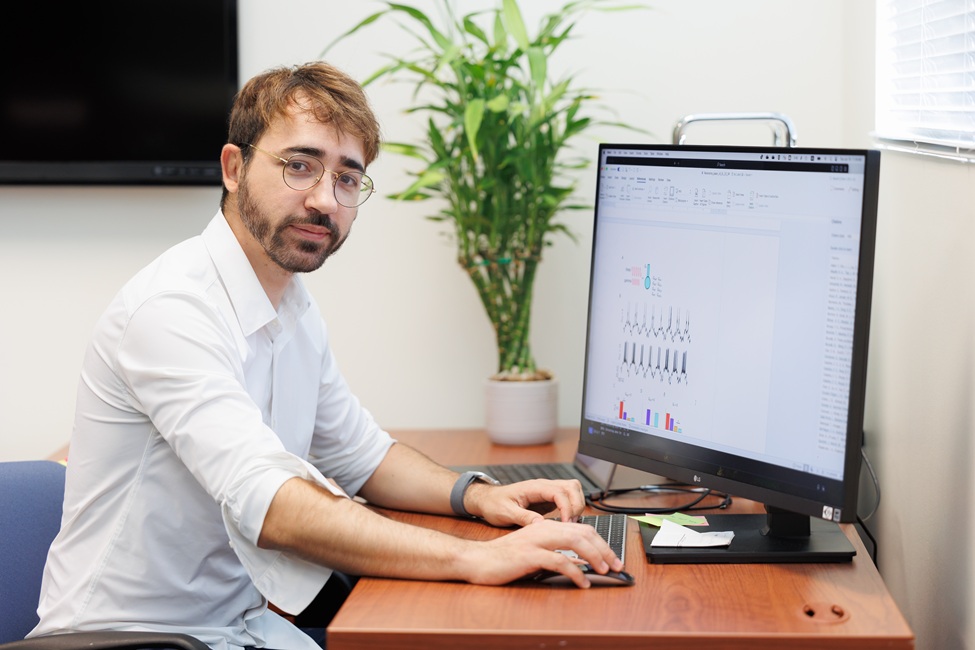In Stereo: Neurons Shift Gears Between Thoughts Using Brain Rhythms

Rodrigo Pena, Ph.D., senior author, an assistant professor of biological sciences, FAU Charles E. Schmidt College of Science and a member of the FAU Stiles-Nicholson Brain Institute.
The brain is constantly mapping the external world like a GPS, even when we don’t know about it. This activity comes in the form of tiny electrical signals sent between neurons – specialized cells that communicate with one another to help us think, move, remember and feel. These signals often follow rhythmic patterns known as brain waves, such as slower theta waves and faster gamma waves, which help organize how the brain processes information.
Understanding how individual neurons respond to these rhythms is key to unlocking how the brain functions related to navigation in real time – and how it may be affected in disease.
A new study by Florida Atlantic University and collaborators from Erasmus Medical Center, Rotterdam, Netherlands, and the University of Amsterdam, Netherlands, has uncovered a surprising ability of brain cells in the hippocampus to process and encode and respond to information from multiple brain rhythms at once.
The research, published in PLOS Computational Biology, reveals how a single neuron can switch between firing single spikes and rapid bursts depending on both its internal properties and the brain’s ongoing electrical activity – a phenomenon the researchers have termed “interleaved resonance.”
This discovery offers a new understanding of how the brain organizes thoughts for navigation, memories and behaviors and may have important implications for neurological conditions that are implicated to spatial memory and learning such as epilepsy, Alzheimer’s disease and schizophrenia.
The study focused on CA1 pyramidal neurons – a type of brain cell critical for memory formation and spatial navigation – how we figure out where we are and how to get from one place to another. These cells communicate by firing electrical impulses, either as isolated single spikes or as rapid bursts. Each firing mode carries different types of information and is associated with specific behavioral contexts. Until now, the factors that determine when and how these neurons switch between modes were poorly understood.
Using advanced computational modeling and cutting-edge voltage imaging of real brain activity, the researchers demonstrated that neurons can respond to both theta (slow) and gamma (fast) brain wave inputs at the same time – but in different ways. The result is a form of double-coding, where a neuron uses bursts to resonate with theta waves and single spikes to resonate with gamma waves – both simultaneously embedded in the same electrical signal.
“Our models show that a single neuron can behave like a multi-band radio, tuning in to different frequencies and changing its behavior accordingly,” said Rodrigo Pena, Ph.D., senior author, an assistant professor of biological sciences, within FAU’s Charles E. Schmidt College of Science on the John D. MacArthur Campus in Jupiter, and a member of the FAU Stiles-Nicholson Brain Institute. “It’s a much more flexible and powerful system than we previously imagined.”
The team found that this behavior is influenced by the neuron’s internal settings – specifically, the levels of three ion-driven currents: persistent sodium, delayed rectifier potassium and hyperpolarization-activated current. By adjusting these internal conductances, neurons can shift their resonance preferences between theta and gamma waves, and between burst and single-spike firing. Additionally, neurons were more likely to fire bursts after long silent periods, introducing a time-dependent element to how information is encoded.
“This ability to ‘double code’ offers a new perspective on how the brain efficiently organizes and transfers information and could have broad implications for neurological conditions where brain rhythms are disrupted,” said Pena. “If neurons are misfiring or unable to switch between single spikes and bursts appropriately, it could interfere with how memories are formed or how attention is directed. If we understand how neurons naturally adjust to different brain rhythms, then we can start to think about how to restore that flexibility in conditions where it’s lost.”
The findings also shed light on long-standing questions in neuroscience, including how spatial memory is formed in the hippocampus, and underscore the complexity and adaptability of the brain. Previous research showed that theta and gamma rhythms influence when and how neurons fire as an animal moves through space. This new work shows that neurons are not locked into one firing mode but can dynamically shift their response depending on both external input and their internal electrical environment. In other words, a single neuron isn’t limited to sending just one type of signal – it can carry multiple layers of information depending on the context.
“The brain’s building blocks are far more dynamic than once thought,” said Pena. “A neuron can simultaneously follow different brain rhythms, adjusting its firing patterns to match the needs of the moment. This discovery not only advances our understanding of how the brain works but could one day help guide treatments aimed at restoring healthy neural function when things go wrong.”
Study co-authors are César C. Ceballos, Ph.D., first author and a postdoctoral fellow, FAU Charles E. Schmidt College of Science; Nourdin Chadly, Ph.D., Erasmus Medical Center and University of Amsterdam; and Erik Lowet, Ph.D., an assistant professor, Neuroscience Department, Erasmus Medical Center.
-FAU-
Latest Research
- FAU's Amy Wright, Ph.D., Honored for Marine Drug Discovery ResearchFAU Harbor Branch researcher Amy Wright, Ph.D., has received the prestigious Norman R. Farnsworth ASP Research Achievement Award, the highest accolade presented by the American Society of Pharmacognosy (ASP).
- FAU Joins VIP Consortium, Launches Inaugural Research TeamsFAU is the first university in Florida to join the international VIP Consortium, a global network of more than 50 institutions of higher education, and has selected its first official VIP teams.
- FAU Engineering Awarded USDA Grant for Smart Farming BreakthroughThis groundbreaking, multi-institutional research project is aimed at revolutionizing the future of precision agriculture through the development of an advanced edge/fog computing-based framework.
- New FAU-USF Research Rewrites Origins of the World's First PandemicFor the first time, FAU-USF researchers have found direct genomic evidence of the Plague of Justinian in the Eastern Mediterranean, where the world's first recorded pandemic began nearly 1,500 years ago.
- FAU Tells 'Story' of Atlantic's Sargassum Surge Using 40 Years of DataFAU Harbor Branch's landmark review reveals 40 years of change in pelagic sargassum - its growth, drivers and rising biomass across the North Atlantic, impacting the ocean's vital ecosystem.
- FAU Engineering Celebrates Journal of Big Data's Decade of ExcellenceCo-founded by FAU College of Engineering and Computer Science faculty, the Journal of Big Data stands as a world-leading publication, ranked No. 1 globally among peer journals and conferences in the domain.






